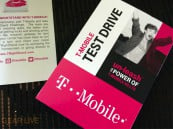Find Our Latest Video Reviews on YouTube!
If you want to stay on top of all of our video reviews of the latest tech, be sure to check out and subscribe to the Gear Live YouTube channel, hosted by Andru Edwards! It’s free!
Tuesday July 10, 2012 12:59 pm
How my Chevy Volt almost got me seriously injured (or killed)

Update 1: We're trying to deal with Chevy to get resolution that both us and the dealer believes to be the best option. GM would rather us forget about everything, it seems.
We've been keeping tabs on the Chevy Volt ever since the electric vehicle was unveiled in September 2008. We covered the 230 MPG announcement, and were on-hand for the introduction of the OnStar Mobile Integration announcement which showed how you would be able to send commands from your smartphone directly to your Volt (and other OnStar-equipped vehicles) remotely. While there were other pure EVs out there, the maximum range would leave some stranded without any other option but getting towed while the Volt had a gas tank that could run a generator to continue creating electric power even when the pure electric battery ran out. The Volt, in our minds, was the car of the near-future. Until EV range is bumped high enough to never cause charge anxiety, Chevy's flagship EV provided the best trade-off. So we leased one. That's where things started to go very wrong.
Let's be clear - products can have problems. I've had computers, smartphones, and tablets that I purchased brand new, and they just didn't work like they should. For example, when my iPhone 4 went from a full charge to dead in under 2 hours, I brought it to the Apple Store, they saw there was a problem, and they handed me a new one. Just because there was a problem with my iPhone 4 did not mean that there was a problem with the iPhone 4 line of smartphones. I just got a bad one. The same can (and, make no mistake about it, does) happen with automobiles. The problem is that the car manufacturers don't simply replace your vehicle, even if what they sold you is defective when compared to what the typical buyer gets. That's why the Lemon Law is in place.
This past Sunday marked 10 weeks that we've had the 2012 Chevy Volt. In that amount of time, it's been back to the dealership four times due to problems. One of the issues we were told was definitely fixed (a problem with the tire pressure monitor system) came right back two days after it was repaired. Another time the car simply would no longer charge, or rather, would start and stop charging very quickly, as if it was being plugged in and unplugged and plugged back in every few seconds. Definitely not standard or typical behavior--an obvious defect. None of the trips were quick fixes either, requiring at least a few days before we'd have the car back.
These were all annoyances and inconveniences, though. It sucked having a new vehicle that we saw as the future and having it in for service three times over the course of the first few weeks, but we weren't in any danger. That changed with the latest issue that cropped up with the Volt.
I took a quick trip to the store, about a mile or so from Gear Live HQ, with no problem. On the drive back, things seemed fine as well. I stopped in a turn lane to wait for traffic to pass before I made my left across 2 lanes of highway traffic. Once it was good, I hit the gas to complete my turn…and the car stopped going mid-turn. The cars that were coming towards me slammed on their brakes once they realized that I was no longer in motion (if I had been, their speed wouldn't have been an issue.) Two cars narrowly avoided hitting me at 45-50 MPH, which would have resulted in injuries to me, and the drivers of the other vehicles. Unexpected high speed collisions are just bad all around. Thankfully, there was no contact. One driver was able to stop just a few feet from me, while the other swerved to the side to avoid hitting me.
This all happened without warning from the Volt. No check engine light or chime alerted me that anything was wrong. I continued to step on the gas, and the car would only go a maximum of 3 MPH. It would stall out, and start back again going a couple of miles per hour, but never more than 3 MPH. Because of this, it took me about 30 seconds to cross the two lanes that typically takes 2 seconds to do.
After that turn, my final destination was 3 blocks away with no stop signs or traffic, and it took minutes to get there. There's a slight incline--two small hills--and the Volt continued to stall, slide backwards down the hill, then move forward again at a snail's pace. The car was going to need it's fourth trip to the dealership to be serviced in the two months that we'd had it…but this time, the problems with the car put us directly in danger.
After some research and speaking with OnStar, it turned out that they were able to see an error code that the vehicle provided: POAC4. The electric propulsion system failed. I did a bit of research and found quite a bit of help on the GM Volt forums (beware, there are also plenty there who'll question anything negative you have to say about an expensive vechile that you committed to buy with your hard-earned money.) Two points were most interesting in my research:
- If you get an error code from OnStar and plug it in to Google, you can find a wealth of information about what it means, how other owners dealt with it, and how the specific error was fixed. For my error code, there is nothing. Users on the Volt forums even commented that this is the first time this specific issue has been brought up. To me, that indicates that it is not typical, and that the vehicle is faulty.
-
It's possible (or very likely) that this issue was caused by the service department at the dealership. One of the initial trips to the dealer was to handle a recall advisory on the battery. The best explaination comes from GM Volt forum member Henry_FL:
Yours would have had the battery structural enhancement done by the dealer, CU14500 is about the cutoff where they started doing them at the factory.
They drop the battery (which means disconnecting the coolant line, and electrical connectors), add sheet metal to the tunnel, put a low coolant sensor on the radiator for the battery coolant line and but it all back together. There have been at least 5-6 reported cracked radiators, a few "bad" or mis-wired sensors for the coolant level, and others have had the battery overheat or car shutdown because of the sensor. In one coolant got into the electronics due to sloppy mechanics when they disconnected the coolant lines.
Every single problem you listed is dealer caused in one way or another, that's why I and others repeatedly said find a different dealer, your dealers is incompetent and they suck.
We almost never had members complain about the Volt before March and that's when dealers started doing the recalls, or whatever the PC term is. It's been non-stop lately the issues and complaints, and almost every one of the issues can be traced backed to poor dealer workmanship.
These guys can find ways to f--- up oil changes, and now GM has them doing an enhancement that takes a pair of mechanics over 9 hours.
Makes sense to us. We've been working with our Volt Advisor, Kelsey, as well as other advisors in her absence. We've also been working with the dealership. Today is the 8th day that the Volt has been gone, stuck in service to get this problem repaired. It's now ready to be picked up, but we've lost all confidence that this car is safe to drive. Again, I'm referring to this specific car--not the entire Chevy Volt line of vehicles. We've made this clear to the dealership and to the Volt Advisor team.
We've saved hundreds of dollars in gas in the time we've owned the vehicle when compared to the Cadillac CTS we'd had before the Volt. The car is fun to drive, and it feels good to be emissions-free for almost the entire duration. The problem is that the Volt--our specific Volt--is defective and due to either a manufacturer error or a service error (but definitely not user error) the electric propulsion system failed at a time where I really needed it to work. In the 70 days since we drove it home, it's been in service for 15 days, an average of once every two weeks.
We plan on speaking with the Volt Advisor team again today. We'll update with what Chevy is gonna do to help. I'm not really confident that this will turn out.











